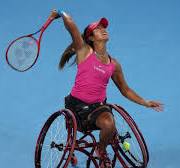Wheelchair tennis has emerged as one of the most dynamic and inspiring sports at the Paralympics, showcasing the incredible skill and determination of its athletes. Explore the history, training, and impact of this remarkable sport, and understand its unique place in promoting inclusivity.
The History of Wheelchair Tennis in the Paralympics
Wheelchair tennis made a remarkable debut at the Paralympics in Barcelona, 1992. Its inclusion marked a historic stride for inclusive sports. Emerging initially in the mid-1970s as a rehabilitation activity, wheelchair tennis soon caught the attention of sports enthusiasts worldwide. Thanks to the pioneering efforts of athletes like Brad Parks, often referred to as the “father of wheelchair tennis,” the sport transitioned from recreational play to a competitive global arena.
The road to the Paralympics wasn’t devoid of challenges. Early proponents advocated tirelessly for wheelchair tennis to gain international recognition. Winning critical milestones, such as the establishment of the International Wheelchair Tennis Federation in 1988, paved the way for the sport’s entry into the Paralympics. The determination and passion of those early athletes not only broke barriers but have also laid the groundwork for generations of aspiring players.
The historic inclusion of wheelchair tennis in the Paralympics signified more than just a sporting opportunity. It heralded a shift in society’s view towards athletes with disabilities, generating wider acceptance and respect. This legacy continues to inspire and empower current and future athletes to achieve their dreams on the world stage. The significance of such milestones cannot be overemphasized, as they serve as a testament to the resilience and spirit inherent in Paralympic athletes.
Training and Skill Development in Wheelchair Tennis
Wheelchair tennis demands a unique blend of physical prowess and mental resolve, akin to what’s required in gymnastics. Training routines emphasize core strength, agility, and precise coordination. Athletes engage in specialized drills that enhance upper body strength, as agility plays a crucial role in rapid direction changes on the court. Sessions often include exercises focusing on endurance and cardiovascular health, crucial for long matches.
Coaches stress the importance of developing a strong mental game. Visualization techniques similar to those used in gymnastics help players anticipate opponent moves. Mental toughness exercises are integral, ensuring players remain composed under pressure. The balance between physical and psychological training fosters resilience, a trait both gymnasts and wheelchair tennis players find invaluable.
Cross-training benefits are profound. Gymnastic techniques enhance flexibility and balance, aiding wheelchair maneuvers. Conversely, wheelchair tennis hones hand-eye coordination, contributing to gymnastics routines. The parallels between the sports highlight how shared skills can elevate performance.
Ultimately, the rigorous training in wheelchair tennis fosters a profound discipline, echoing the dedication found in gymnastics. Athletes emerge from the process not only physically prepared but mentally fortified, ready to tackle the challenges of high-level competition. For those interested, exploring the fundamentals of gymnastics can offer additional insights into these training parallels.
The Impact of Wheelchair Tennis on Inclusivity
Wheelchair tennis has become a shining beacon of inclusivity in the world of sports, serving to break down barriers and empower athletes with disabilities. Beyond being a competitive sport, wheelchair tennis is a platform for showcasing resilience, talent, and triumph over adversity. By providing opportunities that emphasize skill over limitation, the sport opens doors for personal and professional growth for many athletes.
Inspirational stories abound within the community. Take, for example, the tale of a wheelchair tennis player who transforms personal challenges into public victories, embodying the spirit of empowerment. Her journey reflects the perseverance often observed in gymnastics, where athletes push boundaries to overcome physical limitations. This relentless dedication and perseverance have a profound influence not just on spectators, but also within the wider sports community.
The ripple effect of inclusivity in wheelchair tennis reaches beyond the courts. It encourages a societal shift towards acceptance and integration, fostering a world where athletes are celebrated for their abilities, not defined by their disabilities. Just as gymnastics enhances children’s learning and physical development, wheelchair tennis inspires a movement towards greater inclusivity, breaking down prejudices one match at a time.
Equipment Essentials for Aspiring Wheelchair Tennis Players
For aspiring wheelchair tennis players, having the right equipment is crucial. First on the list is the wheelchair itself, tailored specifically for tennis movements. Lightweight and durable are the key traits to seek. Opt for a design with a wide wheelbase and cambered wheels to enhance stability and agility on the court. Adjustable seat heights are essential for optimal balance and control.
Next, consider a custom-fit cushion that provides comfort and reduces the risk of pressure sores. A well-fitted cushion can significantly aid in maintaining posture during high-intensity matches. For rackets, lightweight models crafted from quality materials like graphite can improve swing speed and control. Ensure the grip suits your hand, offering comfort and a firm hold.
Equally important are safety considerations. Helmets and gloves can be invaluable, especially for those transitioning from casual play to competitive environments. Regular maintenance of the wheelchair is non-negotiable. Routine checks on the frame, tires, and bearings can prevent unexpected breakdowns mid-match.
When purchasing, investing in reputable equipment can offer long-term savings, enhancing durability and performance. Knowledgeable advisors at sporting goods stores can offer valuable insights for beginners. Though initially overwhelming, understanding these essentials empowers players to focus on their game, ensuring they’re equipped for success both on and off the court.
Future of Wheelchair Tennis and Global Impact
As wheelchair tennis evolves, so do the prospects for its future growth and impact on a global scale. Emerging technologies such as lighter, stronger materials for wheelchairs may soon revolutionize how adaptive sports equipment is designed. The result could be even more dynamic gameplay, opening the sport to a broader audience and encouraging greater participation.
Inclusivity is becoming increasingly important in sports, and this trend suggests that organizations will seek partnerships to bolster wheelchair tennis worldwide. Collaborations between sports academies and healthcare providers could play a pivotal role in guiding aspiring athletes. Investing in local programs will aid in nurturing talent from diverse backgrounds, creating a truly global stage for competitions.
Moreover, digital platforms present a unique opportunity. Online training modules and virtual coaching sessions could offer unparalleled access to expertise, particularly for players in remote areas. The community that surrounds wheelchair tennis is poised to grow, extending its reach to everyday people who seek inspiration and empowerment.
To stay updated on similar trends and opportunities in other sports disciplines, visit Gymnastics Near To Me’s blog. This offers keen insights into how participatory sports like gymnastics continue to transform communities.
Through concerted efforts and innovative strategies, wheelchair tennis holds the potential to reshape the landscape of adaptive sports, bringing more challengers and champions to the world’s courts.
Final words
Wheelchair tennis not only highlights athleticism and skill but also breaks barriers by promoting inclusivity and resilience. As the sport grows, so does the inspiration it offers to aspiring athletes worldwide. By embracing the challenges and triumphs of its players, wheelchair tennis continues to leave a lasting impact.

